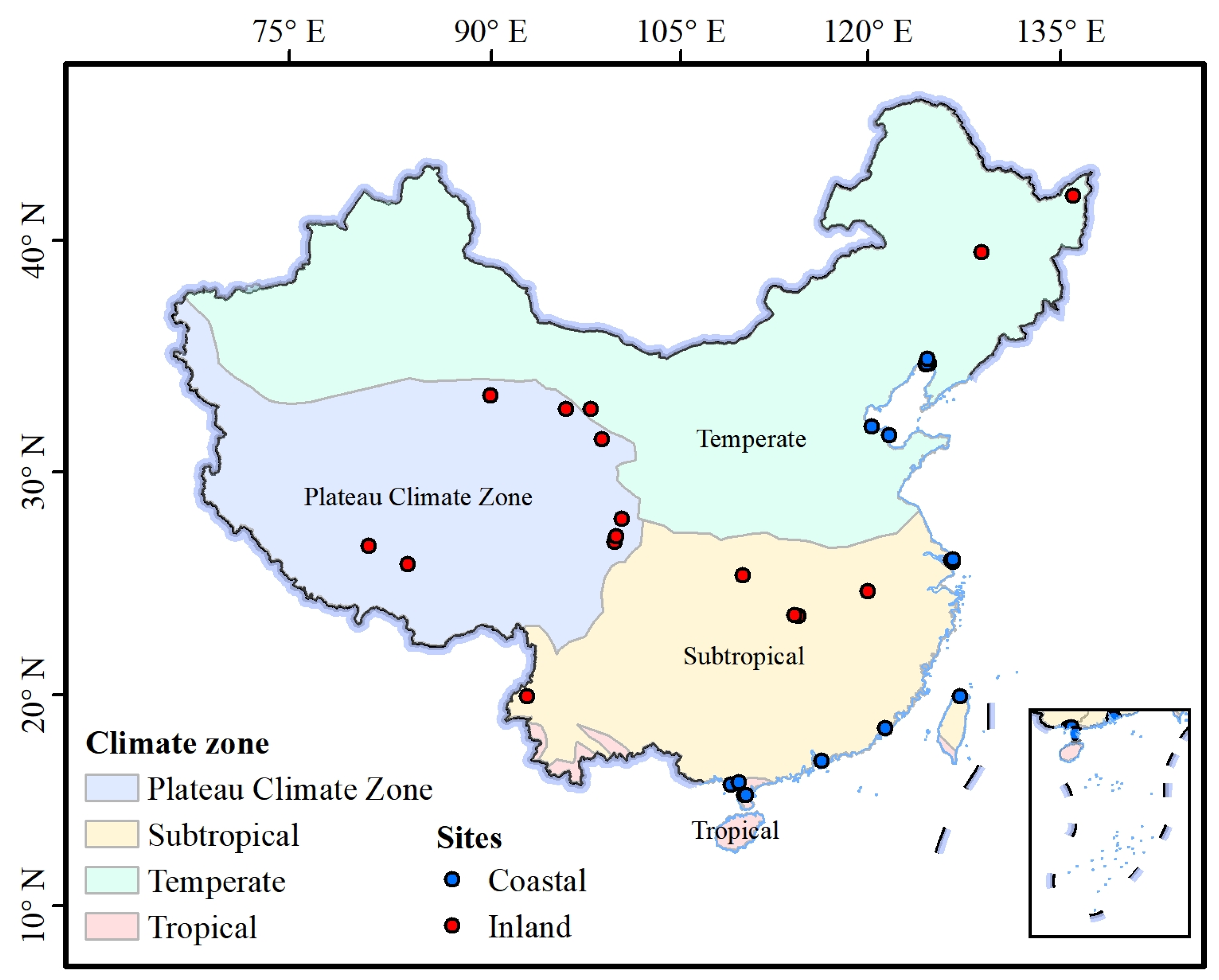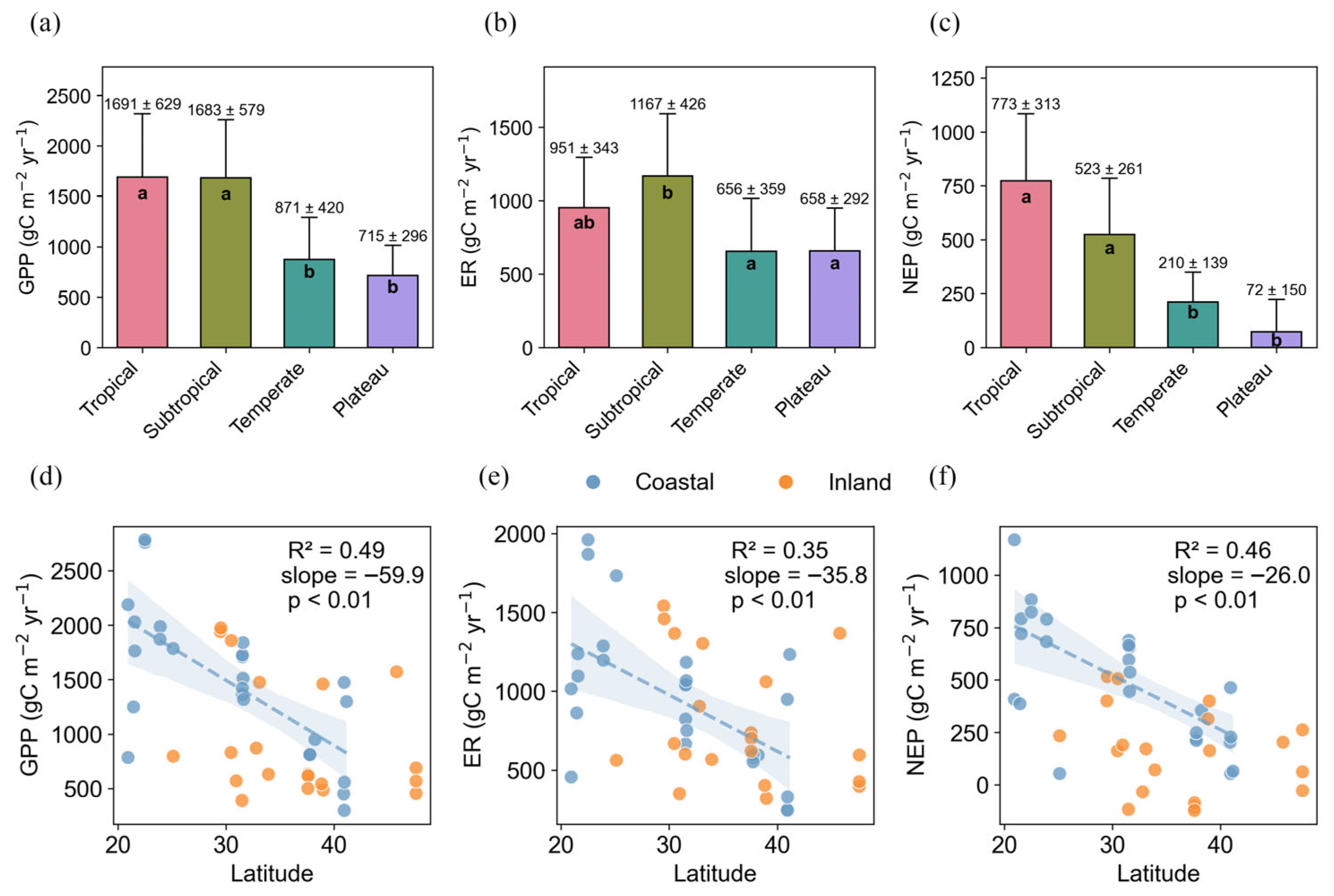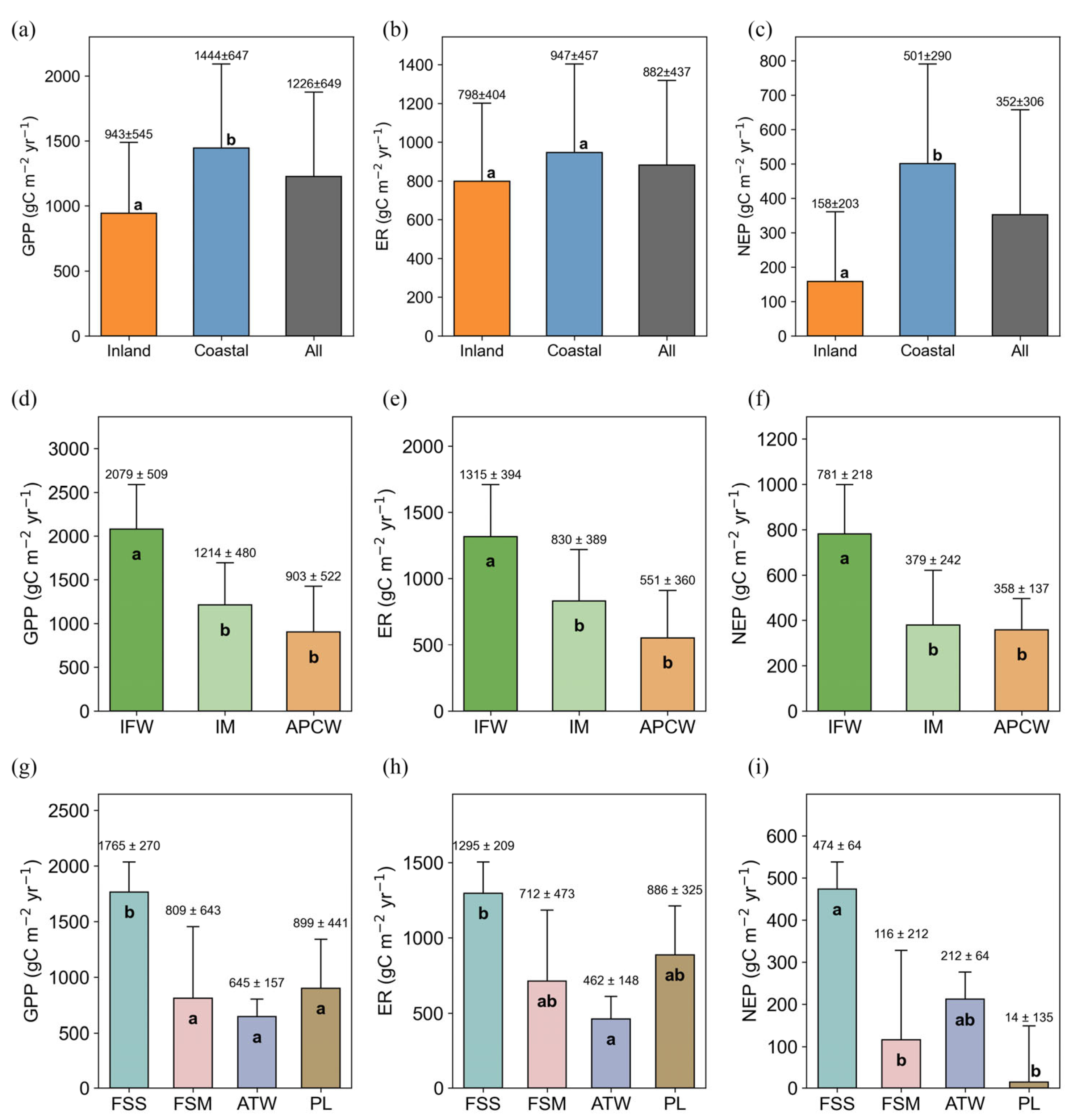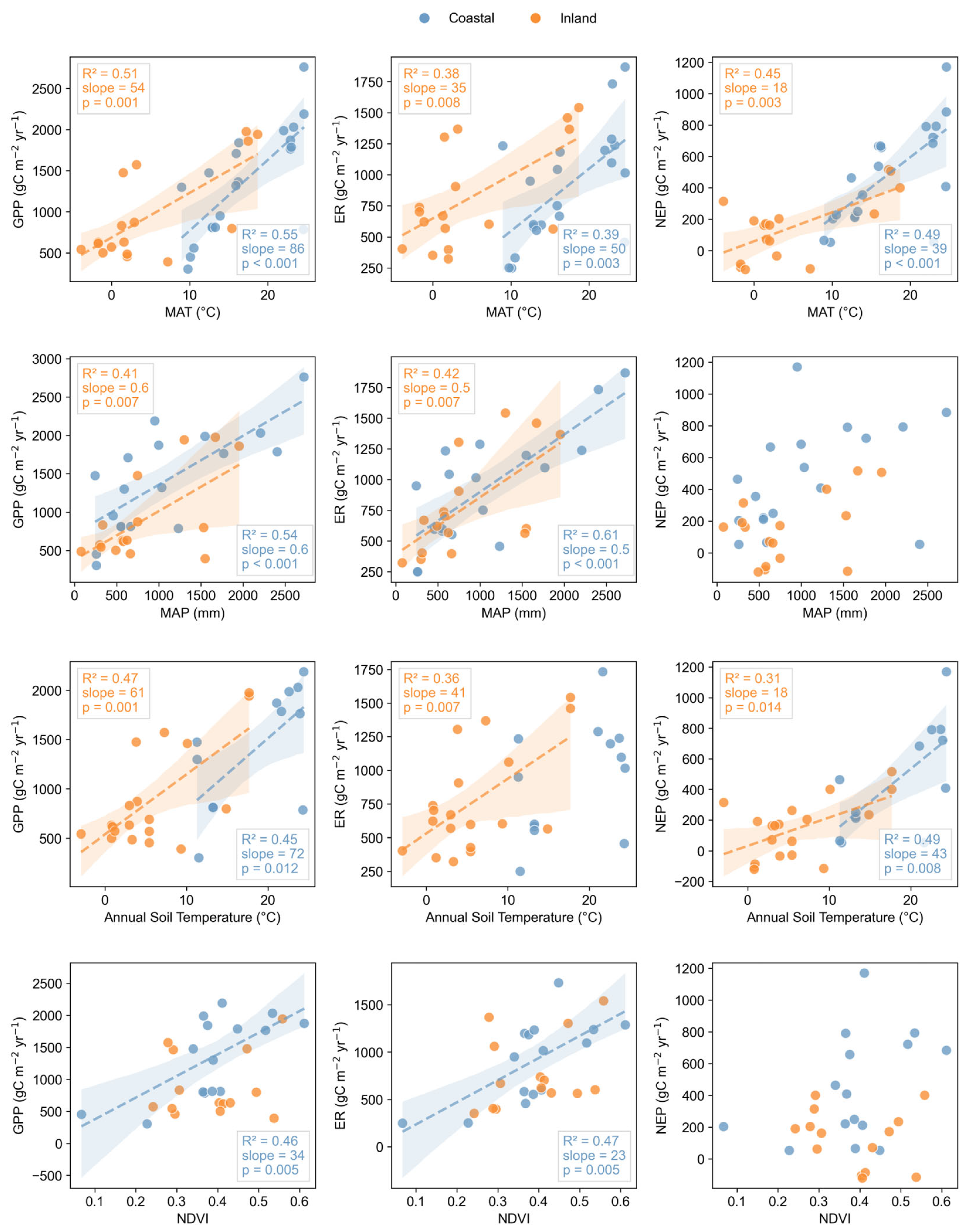Spatial Patterns and Controlling Mechanisms of CO2 Fluxes Across China’s Diverse Wetlands Based on Eddy Covariance Measurements
Abstract
1. Introduction
2. Materials and Methods
2.1. Data Collection and Processing
2.1.1. Eddy Covariance Observations
2.1.2. Environment Data from Remote Sensing
2.2. Data Analysis
3. Results
3.1. Spatial Patterns of Annual GPP, ER, and NEP Across Different Climate Zones
3.2. The Comparison of GPP, ER, and NEP in Different Wetland Types
3.3. The Comparison of Carbon Allocation in Different Wetland Types
3.4. The Effects of Environmental Variables on GPP, ER, and NEP
4. Discussion
4.1. Differences in Carbon Dioxide Fluxes Between Inland and Coastal Wetlands
4.2. Carbon Allocation in Coastal and Inland Wetland Ecosystems
4.3. Spatial Patterns of Ecosystem Carbon Fluxes and Controlling Mechanisms in China’s Wetland
5. Conclusions
Supplementary Materials
Author Contributions
Funding
Data Availability Statement
Acknowledgments
Conflicts of Interest
References
- Zhou, L.; Zhou, G.; Jia, Q. Annual Cycle of CO2 Exchange Over a Reed (Phragmites australis) Wetland in Northeast China. Aquat. Bot. 2009, 91, 91–98. [Google Scholar] [CrossRef]
- Zhang, F.; Liu, A.; Li, Y.; Zhao, L.; Wang, Q.; Du, M. CO2 Flux in Alpine Wetland Ecosystem on the Qinghai-Tibetan Plateau, China. Acta Ecol. Sin. 2008, 28, 453–462. [Google Scholar] [CrossRef]
- Bonneville, M.-C.; Strachan, I.B.; Humphreys, E.R.; Roulet, N.T. Net ecosystem CO2 exchange in a temperate cattail marsh in relation to biophysical properties. Agric. For. Meteorol. 2008, 148, 69–81. [Google Scholar] [CrossRef]
- Chmura, G.L.; Anisfeld, S.C.; Cahoon, D.R.; Lynch, J.C. Global carbon sequestration in tidal, saline wetland soils. Glob. Biogeochem. Cycles 2003, 17, 1111. [Google Scholar] [CrossRef]
- Lu, W.; Xiao, J.; Liu, F.; Zhang, Y.; Liu, C.a.; Lin, G. Contrasting ecosystem CO2 fluxes of inland and coastal wetlands: A meta-analysis of eddy covariance data. Glob. Change Biol. 2016, 23, 1180–1198. [Google Scholar] [CrossRef]
- Cao, S.; Cao, G.; Feng, Q.; Han, G.; Lin, Y.; Yuan, J.; Wu, F.; Cheng, S. Alpine wetland ecosystem carbon sink and its controls at the Qinghai Lake. Environ. Earth Sci. 2017, 76, 210. [Google Scholar] [CrossRef]
- Chu, H.; Gottgens, J.F.; Chen, J.; Sun, G.; Desai, A.R.; Ouyang, Z.; Shao, C.; Czajkowski, K. Climatic variability, hydrologic anomaly, and methane emission can turn productive freshwater marshes into net carbon sources. Glob. Change Biol. 2014, 21, 1165–1181. [Google Scholar] [CrossRef]
- Chmura, G.L. What do we need to assess the sustainability of the tidal salt marsh carbon sink? Ocean. Coast. Manag. 2013, 83, 25–31. [Google Scholar] [CrossRef]
- Wilson, B.J.; Mortazavi, B.; Kiene, R.P. Spatial and temporal variability in carbon dioxide and methane exchange at three coastal marshes along a salinity gradient in a northern Gulf of Mexico estuary. Biogeochemistry 2015, 123, 329–347. [Google Scholar] [CrossRef]
- Kayranli, B.; Scholz, M.; Mustafa, A.; Hedmark, Å. Carbon Storage and Fluxes Within Freshwater Wetlands: A Critical Review. Wetlands 2009, 30, 111–124. [Google Scholar] [CrossRef]
- Bernal, B.; Mitsch, W.J. Comparing carbon sequestration in temperate freshwater wetland communities. Glob. Change Biol. 2012, 18, 1636–1647. [Google Scholar] [CrossRef]
- Ma, Z.; Lu, M.; Jin, H.; Sheng, X.; Wei, H.; Yang, Q.; Qi, L.; Huang, J.; Chen, L.; Dou, X. Greenhouse gas emissions and environmental drivers in different natural wetland regions of China. Environ. Pollut. 2023, 330, 121754. [Google Scholar] [CrossRef] [PubMed]
- Hu, M.; Sardans, J.; Yang, X.; Peñuelas, J.; Tong, C. Patterns and environmental drivers of greenhouse gas fluxes in the coastal wetlands of China: A systematic review and synthesis. Environ. Res. 2020, 186, 109576. [Google Scholar] [CrossRef] [PubMed]
- Wang, J.; Yu, G.; Han, L.; Yao, Y.; Sun, M.; Yan, Z. Ecosystem carbon exchange across China’s coastal wetlands: Spatial patterns, mechanisms, and magnitudes. Agric. For. Meteorol. 2024, 345, 109859. [Google Scholar] [CrossRef]
- Barbier, E.B.; Hacker, S.D.; Kennedy, C.; Koch, E.W.; Stier, A.C.; Silliman, B.R. The value of estuarine and coastal ecosystem services. Ecol. Monogr. 2011, 81, 169–193. [Google Scholar] [CrossRef]
- State Forestry Administration (SFA). Outcomes of the Second National Wetland Resources Survey. Available online: http://www.china.com.cn/zhibo/zhuanti/ch-xinwen/2014-01/13/content_31170329.htm (accessed on 26 July 2025).
- National Bureau of Statistics of China (NBSC). China Statistical Yearbook; China Statistics Press: Beijing, China, 2022; ISBN 978-7-5037-9950-1.
- Olefeldt, D.; Euskirchen, E.S.; Harden, J.; Kane, E.; McGuire, A.D.; Waldrop, M.P.; Turetsky, M.R. A decade of boreal rich fen greenhouse gas fluxes in response to natural and experimental water table variability. Glob. Change Biol. 2017, 23, 2428–2440. [Google Scholar] [CrossRef]
- Estop-Aragonés, C.; Zając, K.; Blodau, C. Effects of extreme experimental drought and rewetting on CO2 and CH4 exchange in mesocosms of 14 European peatlands with different nitrogen and sulfur deposition. Glob. Change Biol. 2016, 22, 2285–2300. [Google Scholar] [CrossRef]
- Zhong, Q.; Wang, K.; Lai, Q.; Zhang, C.; Zheng, L.; Wang, J. Carbon Dioxide Fluxes and Their Environmental Control in a Reclaimed Coastal Wetland in the Yangtze Estuary. Estuaries Coasts 2015, 39, 344–362. [Google Scholar] [CrossRef]
- Chu, X.; Han, G.; Wei, S.; Xing, Q.; He, W.; Sun, B.; Li, X.; Hui, D.; Wu, H.; Wang, X.; et al. Seasonal not annual precipitation drives 8-year variability of interannual net CO2 exchange in a salt marsh. Agric. For. Meteorol. 2021, 308–309, 108557. [Google Scholar] [CrossRef]
- Gou, R.; Feng, J.; Zhou, H.; Lang, T.; Zhao, J.; Mo, L.; Song, S.; Lin, G. CO2 fluxes contrast between aquaculture ponds and mangrove forests and its implications for coastal wetland rehabilitation in Leizhou Peninsula, China. Agric. Ecosyst. Environ. 2024, 367, 108968. [Google Scholar] [CrossRef]
- Rodda, S.R.; Thumaty, K.C.; Fararoda, R.; Jha, C.S.; Dadhwal, V.K. Unique Characteristics of Ecosystem CO2 Exchange in Sundarban Mangrove Forest and Their Relationship with Environmental Factors. Estuar. Coast. Shelf Sci. 2022, 267, 107764. [Google Scholar] [CrossRef]
- Zhang, Q.; Sun, R.; Jiang, G.; Xu, Z.; Liu, S. Carbon and energy flux from a Phragmites australis wetland in Zhangye oasis-desert area, China. Agric. For. Meteorol. 2016, 230–231, 45–57. [Google Scholar] [CrossRef]
- Wei, D.; Qi, Y.; Ma, Y.; Wang, X.; Ma, W.; Gao, T.; Huang, L.; Zhao, H.; Zhang, J.; Wang, X. Plant uptake of CO2 outpaces losses from permafrost and plant respiration on the Tibetan Plateau. Proc. Natl. Acad. Sci. USA 2021, 118, e2015283118. [Google Scholar] [CrossRef] [PubMed]
- Xiao, D.; Deng, L.; Kim, D.G.; Huang, C.; Tian, K. Carbon budgets of wetland ecosystems in China. Glob. Change Biol. 2019, 25, 2061–2076. [Google Scholar] [CrossRef] [PubMed]
- Han, G.; Xing, Q.; Yu, J.; Luo, Y.; Li, D.; Yang, L.; Wang, G.; Mao, P.; Xie, B.; Mikle, N. Agricultural reclamation effects on ecosystem CO2 exchange of a coastal wetland in the Yellow River Delta. Agric. Ecosyst. Environ. 2014, 196, 187–198. [Google Scholar] [CrossRef]
- Han, G.; Chu, X.; Xing, Q.; Li, D.; Yu, J.; Luo, Y.; Wang, G.; Mao, P.; Rafique, R. Effects of episodic flooding on the net ecosystem CO2 exchange of a supratidal wetland in the Yellow River Delta. J. Geophys. Res. Biogeosciences 2015, 120, 1506–1520. [Google Scholar] [CrossRef]
- Lembrechts, J.J.; van den Hoogen, J.; Aalto, J.; Ashcroft, M.B.; De Frenne, P.; Kemppinen, J.; Kopecký, M.; Luoto, M.; Maclean, I.M.D.; Crowther, T.W.; et al. Global maps of soil temperature. Glob. Change Biol. 2022, 28, 3110–3144. [Google Scholar] [CrossRef]
- Vehtari, A.; Gelman, A.; Gabry, J. Practical Bayesian model evaluation using leave-one-out cross-validation and WAIC. Stat. Comput. 2016, 27, 1413–1432. [Google Scholar] [CrossRef]
- Yan, P.; Fernández-Martínez, M.; Van Meerbeek, K.; Yu, G.; Migliavacca, M.; He, N. The essential role of biodiversity in the key axes of ecosystem function. Glob. Change Biol. 2023, 29, 4569–4585. [Google Scholar] [CrossRef]
- Li, J.; Yuan, J.; Ciais, P.; Kang, H.; Freeman, C.; Huang, Y.; Dong, Y.; Liu, D.; Li, Y.; Ding, W. Two decades of improved wetland carbon sequestration in northern mid-to-high latitudes are offset by tropical and southern declines. Nat. Ecol. Evol. 2025. [Google Scholar] [CrossRef]
- Wang, F.; Liu, J.; Qin, G.; Zhang, J.; Zhou, J.; Wu, J.; Zhang, L.; Thapa, P.; Sanders, C.J.; Santos, I.R.; et al. Coastal blue carbon in China as a nature-based solution toward carbon neutrality. Innovation 2023, 4, 100481. [Google Scholar] [CrossRef]
- Alvarado-Barrientos, M.S.; López-Adame, H.; Lazcano-Hernández, H.E.; Arellano-Verdejo, J.; Hernández-Arana, H.A. Ecosystem-Atmosphere Exchange of CO2, Water, and Energy in a Basin Mangrove of the Northeastern Coast of the Yucatan Peninsula. J. Geophys. Res. Biogeosciences 2021, 126, e2020JG005811. [Google Scholar] [CrossRef]
- Alongi, D.M. Lateral Export and Sources of Subsurface Dissolved Carbon and Alkalinity in Mangroves: Revising the Blue Carbon Budget. J. Mar. Sci. Eng. 2022, 10, 1916. [Google Scholar] [CrossRef]
- Cui, X.; Liang, J.; Lu, W.; Chen, H.; Liu, F.; Lin, G.; Xu, F.; Luo, Y.; Lin, G. Stronger ecosystem carbon sequestration potential of mangrove wetlands with respect to terrestrial forests in subtropical China. Agric. For. Meteorol. 2018, 249, 71–80. [Google Scholar] [CrossRef]
- Sun, B.; Yan, L.; Jiang, M.; Li, X.; Han, G.; Xia, J. Reduced magnitude and shifted seasonality of CO2 sink by experimental warming in a coastal wetland. Ecology 2021, 102, e03236. [Google Scholar] [CrossRef] [PubMed]
- Jordan, T.E.; Correll, D.L.; Whigham, D.F. Nutrient flux in the Rhode River: Tidal exchange of nutrients by brackish marshes. Estuar. Coast. Shelf Sci. 1983, 17, 651–667. [Google Scholar] [CrossRef]
- Yang, L.; Han, G.; Yu, J.; Wu, L.; Zhu, M.; Xing, Q.; Wang, G.; Mao, P. Net Ecosystem CO2 Exchange and its Environmental Regulation Mechanisms in a Reed Wetland in the Yellow River Delta of China During the Growth Season. Chin. J. Appl. Ecol. 2013, 24, 2415–2422. [Google Scholar] [CrossRef]
- Mao, D.; Wang, Z.; Du, B.; Li, L.; Tian, Y.; Jia, M.; Zeng, Y.; Song, K.; Jiang, M.; Wang, Y. National wetland mapping in China: A new product resulting from object-based and hierarchical classification of Landsat 8 OLI images. ISPRS J. Photogramm. Remote Sens. 2020, 164, 11–25. [Google Scholar] [CrossRef]
- Janssens, I.; Lankreijer, H.; Matteucci, G.; Kowalski, A.; Buchmann, N.; Epron, D.; Pilegaard, K.; Kutsch, W.L.; Bernard, L.; Grünwald, T.; et al. Productivity overshadows temperature in determining soil and ecosystem respiration across European forests. Glob. Change Biol. 2001, 7, 269–278. [Google Scholar] [CrossRef]
- Yu, G.R.; Zhu, X.J.; Fu, Y.L.; He, H.L.; Wang, Q.F.; Wen, X.F.; Li, X.R.; Zhang, L.M.; Zhang, L.; Su, W.; et al. Spatial patterns and climate drivers of carbon fluxes in terrestrial ecosystems of China. Glob. Change Biol. 2012, 19, 798–810. [Google Scholar] [CrossRef]
- Chen, Z.; Yu, G.; Zhu, X.; Wang, Q.; Niu, S.; Hu, Z. Covariation between gross primary production and ecosystem respiration across space and the underlying mechanisms: A global synthesis. Agric. For. Meteorol. 2015, 203, 180–190. [Google Scholar] [CrossRef]
- Song, T. Long Term Carbon Dioxide Flux Measurements in Sanjiang Plain, Northeastern China. Ph.D. Thesis, Nanjing University of Information Science and Technology, Nanjing, China, 2007. [Google Scholar]
- Santos, I.R.; Burdige, D.J.; Jennerjahn, T.C.; Bouillon, S.; Cabral, A.; Serrano, O.; Wernberg, T.; Filbee-Dexter, K.; Guimond, J.A.; Tamborski, J.J. The renaissance of Odum’s outwelling hypothesis in ‘Blue Carbon’ science. Estuar. Coast. Shelf Sci. 2021, 255, 107361. [Google Scholar] [CrossRef]
- Yau, Y.Y.; Xin, P.; Chen, X.; Zhan, L.; Call, M.; Conrad, S.R.; Sanders, C.J.; Li, L.; Du, J.; Santos, I.R. Alkalinity export to the ocean is a major carbon sequestration mechanism in a macrotidal saltmarsh. Limnol. Oceanogr. 2022, 67, S158–S170. [Google Scholar] [CrossRef]







Disclaimer/Publisher’s Note: The statements, opinions and data contained in all publications are solely those of the individual author(s) and contributor(s) and not of MDPI and/or the editor(s). MDPI and/or the editor(s) disclaim responsibility for any injury to people or property resulting from any ideas, methods, instructions or products referred to in the content. |
© 2025 by the authors. Licensee MDPI, Basel, Switzerland. This article is an open access article distributed under the terms and conditions of the Creative Commons Attribution (CC BY) license (https://creativecommons.org/licenses/by/4.0/).
Share and Cite
Du, F.; Chen, Z.; Li, X.; Liu, J.; Kan, X.; Wang, Y.; Liu, X.; Yao, D. Spatial Patterns and Controlling Mechanisms of CO2 Fluxes Across China’s Diverse Wetlands Based on Eddy Covariance Measurements. Land 2025, 14, 1629. https://doi.org/10.3390/land14081629
Du F, Chen Z, Li X, Liu J, Kan X, Wang Y, Liu X, Yao D. Spatial Patterns and Controlling Mechanisms of CO2 Fluxes Across China’s Diverse Wetlands Based on Eddy Covariance Measurements. Land. 2025; 14(8):1629. https://doi.org/10.3390/land14081629
Chicago/Turabian StyleDu, Fengfeng, Zengshan Chen, Xixi Li, Jixiang Liu, Xuhui Kan, Yanjie Wang, Xiaojing Liu, and Dongrui Yao. 2025. "Spatial Patterns and Controlling Mechanisms of CO2 Fluxes Across China’s Diverse Wetlands Based on Eddy Covariance Measurements" Land 14, no. 8: 1629. https://doi.org/10.3390/land14081629
APA StyleDu, F., Chen, Z., Li, X., Liu, J., Kan, X., Wang, Y., Liu, X., & Yao, D. (2025). Spatial Patterns and Controlling Mechanisms of CO2 Fluxes Across China’s Diverse Wetlands Based on Eddy Covariance Measurements. Land, 14(8), 1629. https://doi.org/10.3390/land14081629





